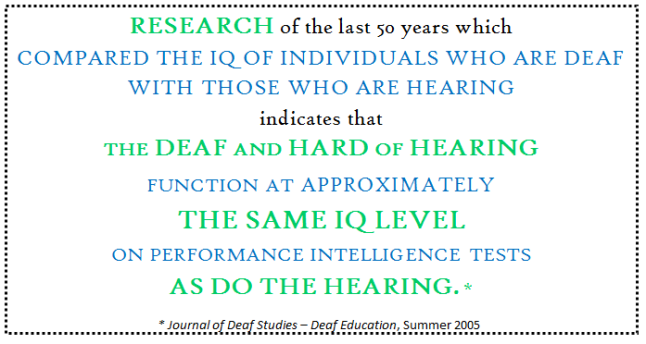In IQ and Deafness I discussed the assumptions about someone’s intelligence that we make based on a person’s speech and language. I named four characteristics that can lead others to misjudge someone’s intelligence.
One of these characteristics is imperfect speech, discussed in Speech and Deafness.
Another effect of deafness that can cause us to make incorrect assumptions is imperfect language.
I will use 2 posts to discuss why those who are deaf sometimes have irregular language. You may also want to read the short post HOW DID YOU LEARN LANGUAGE?
Language & Deafness 1: LANGUAGE vs. SPEECH (this post)
Language & Deafness 2: WHY IS LANGUGAGE DIFFICULT FOR D/HH Students?

Language & Deafness 1: WHAT IS LANGUAGE ?
Sidebar: SPEECH vs LANGUAGE
When we learned in school that nouns and verbs are “Parts of Speech”, that was technically incorrect. Nouns are verbs are really parts of language.
Speech is
- the sounds that we make when we talk. The word cat has three sounds: /k/ /a/ and /t/.
Language is:
- knowing what words means (vocabulary)
- knowing how to put those words together (grammar)
Note: This is a very oversimplified definition of language. People have been discussing and writing books on the subject for thousands of years. There’s a lot more to say about language!
Big Question: WHAT IS LANGUAGE ?
We have said that language has two main components: vocabulary and grammar.
Language Component 1: VOCABULARY – NAMES for ITEMS, ACTIONS & IDEAS
Here are some words: dog – boy – tiger – chased – the – and
To share an idea using these words, we first must know what they mean.
The nouns (dog, boy, tiger) and verb (chased) are easy to learn because we can see examples of them and learn what they mean.
Challenge: explain the meaning of the and and. These are a couple of the words often omitted or misused by D/HH language learners. And think about it: often they can be omitted from a sentence without changing its meaning.
Commonly cited vocabulary statistics:
- a 6-year-old child uses a 2,500-word vocabulary
- the same 6-year-old understands 20,000 words
- a 12-year-old child understands about 50,000 words.
Language Component 2: GRAMMAR – HOW WE PUT WORDS TOGETHER
We all spent 12 years of school learning (among other things) the rules of language. But really, by the time we were 6 years old, we knew the most important rules about how to put words together. You learned these rules by listening to people talk. But language development is much more complex. So much so that scientists don’t yet agree on how it happens. http://www.simplypsychology.org/language.html
Let’s use our familiar set of words to look at some of the most basic language rules.
dog boy tiger chased the and
If I use these words to make a sentence for you, you could create a mental picture that should be a fairly accurate representation of my idea.
I could say

 The dog and the boy chased the tiger. Or, I could say
The dog and the boy chased the tiger. Or, I could say
The dog and tiger chased the boy. Or
The boy and tiger chased the dog.
Each of these sentences creates a different picture. The sentences have a different meaning, even though they use the same six words.
It seems simple.
Rule #1: the order of the words changes the meaning of the sentence.
You know who is chasing and who is being chased in each sentence. That’s because you know the sub-rule: the first noun is the person or thing that is doing the action.

Let’s look again at our first rule: the order of the words changes the meaning of the sentence
Using that rule, these two sentences should have different meanings because the words are in different order.
The dog and the boy chased the tiger.
The boy and the dog chased the tiger.
Do they have different meanings? No.
Why? Because there’s another rule.
Rule #2: The order of the words DOESN’T affect the meaning of the sentence IF two words are joined by and .
But now consider this pair of sentences,which adds 2 words.
The tiger chased the dog.
The tiger was chased by the dog.
The word order is the same, but the chaser and chase-ee have changed parts.
Sentences that use passive voice, like the last example above, are notoriously difficult for language learners.
Rule #3: There are many exceptions to rule #1.
But then there are …. IDIOMS
Idioms are phrases that don’t mean what their words say.
Type 1 Idiom – Colorful phrases
Here’s one popular idiom: It’s raining cats and dogs! We just have to explain this meaning to language learners. And they have to memorize it.
Type 2 Idiom – Multiple meanings
There are also more subtle idioms. Let’s go back to our dog, boy and tiger.
Dog says, “Tiger is after me!” That sentence can mean two entirely different things.
Boy: Dog, why are you running? Dog:Tiger is after me!
Boy: Dog, whose turn is it after yours? Dog: Tiger is after me.
Type 3 Idiom – I-don’t-know-why-we-say-this.
Why do we say, “The alarm went off” when an alarm turns on?
There must be more of these puzzlements. Please share in the comments!
Click here for Language & Deafness 2: WHY IS LANGUAGE DIFFICULT for D/HH Students?








 The dog and the boy chased the tiger. Or, I could say
The dog and the boy chased the tiger. Or, I could say





 Momma!
Momma!



